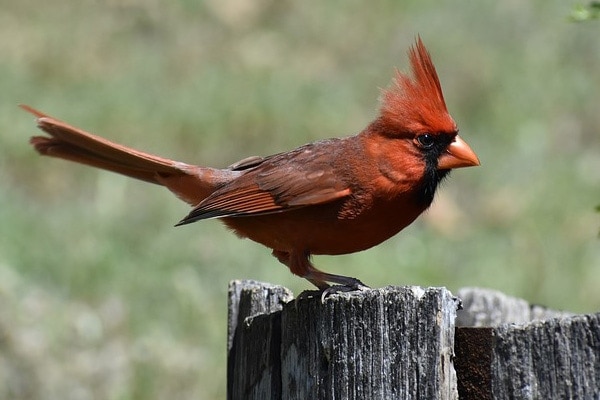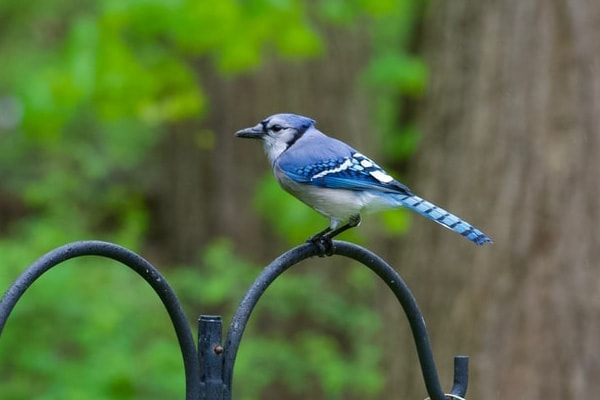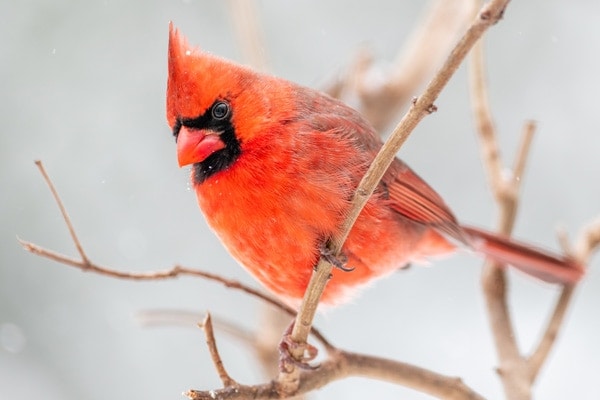Contents
- Personality Traits: How Blue Jays Act In Nature
- Personality Traits: How Cardinals Act In Nature
- Feeding Habits: What Blue Jays Prefer To Eat
- Feeding Habits: What Cardinals Prefer To Eat
- Physical Features & Living Situations: Similarities Amongst Cardinals And Blue Jays
- Body Size: Similarities Amongst Cardinals And Blue Jays
- The Last Word On Whether Blue Jays And Cardinals Are Related
I recently noticed a blue jay and cardinal perched on the same branch sitting next to one another. After looking closely at these two beautiful birds, I started to wonder “Are Blue Jays And Cardinals Related?”. They’re about the same size and have other similarities, so I decided to research the topic and came up with a few interesting answers.
Blue jays and cardinals are not related. Blue jays are part of the Corvidae family of birds including magpies, jackdaws, ravens, rooks, and crows. Cardinals are members of the Cardinalidae family, which is made up of grosbeaks, buntings, and cardinals. At best, they’re both passerines and distant relatives.
And I have much more to say!
Although we now know blue jays and cardinals aren’t related, they possess certain similarities that might convince you otherwise.
Some common characteristics and personality differences that we’ll examine between cardinals and blue jays include:
- Blue jay personality traits
- Cardinal personality traits
- Blue jay feeding habits
- Cardinal feeding habits
- Similarities with blue jay and cardinal physical features
- Similarities with blue jay and cardinal body size
Ready to learn about the commonalities and differences between these two birds?
Keep reading until the end to discover the pure facts.
Personality Traits: How Blue Jays Act In Nature
With a nickname like bully bird, it shouldn’t surprise anyone to learn that blue jays are incredibly aggressive. They are combative, violent, and scream loudly to defend their young and protect their territory.
Unfortunately, in an effort to protect their food sources, they also have a tendency to attack and scare away small birds like chickadees, warblers, and grosbeaks.
Even though they are beautiful, their strong and aggressive personalities turn many people off. They want to see a wide array of birds eating from their bird feeders, so they go out of their way to repel blue jays from their backyard.
A big reason why these birds are aggressive is because they are also prey. Large raptors like hawks, falcons, owls, and eagles harass them, they steal their hatchlings and eggs, and they steal the food from their bird feeders.
With so many enemies, it’s no wonder that blue jays are incredibly hostile.
Personality Traits: How Cardinals Act In Nature
Unlike blue jays, cardinals are not very aggressive birds. As a matter of fact, it’s pretty safe to say that these birds are rather shy. They like to keep to themselves.
Similar to blue jays, male cardinals are responsible for protecting their territory and their unborn eggs during breeding season.
Interestingly enough, blue jays and cardinals act the same because they both aggressively attack male intruders that attempt to encroach on their territory.
But there’s a major difference too…
Instead of violently screaming to sound the alarm and scare off intruders, male cardinals sing in an effort to protect nesting territory. So, that’s a big difference to say the least.
While courting, male and female cardinals will perform a mating ritual in March, May, June, and July. The males will go beak to beak while feeding females seeds, which almost looks like the two are kissing.
They also perform a courtship ritual where they raise up their heads, sing softly, and sway back and forth simultaneously.
On the other hand, blue jays will sing, put themselves on display, and use mating calls to attract potential mates.
Feeding Habits: What Blue Jays Prefer To Eat
Blue jays and cardinal share similar feeding habits in many ways. But there are a few big differences as well.
Blue jays enjoy eating insects, seeds, fruits, and grains. They find these tasty treats in many bird feeders throughout North America and they definitely enjoy this tasty bounty.
As we know, they enjoy it so much that they will take vicious steps to protect bird feeders in their territory.
Here’s where they differ from cardinals:
Even though they enjoy tasty fruits and grains, blue jays are considered omnivores because they also eat mice, frogs, small hatchlings, and unborn bird eggs.
Although this doesn’t sound very appealing to me, these large birds certainly enjoy these tasty treats, although they do not eat unborn bird eggs too often, thankfully.
Feeding Habits: What Cardinals Prefer To Eat
As I said, just like blue jays, cardinals also prefer eating grains, insects, fruits, and seeds. Because of their typical diet, these beautiful red birds are considered granivores.
In particular, cardinal favorites include:
- Nyjer seed
- Sunflower hearts
- Striped sunflower seeds
- Mealworms
- Cracked Corn
- Suet
- Sunflower chips
- Peanuts
- Black oil sunflower seeds
- Safflower seeds
They also enjoy eating natural fruits that they find in the wild including dark-colored berries, mulberries, blueberries, and more.
Physical Features & Living Situations: Similarities Amongst Cardinals And Blue Jays
Although they’re obviously different colors, both blue jays and cardinals have similar physical features. In particular, they have similar markings and very similar color contrasts in the colors of their feathers.
As an example:
The color of cardinals is obviously predominantly red. It is their main background color. But they also have black or white stripes, depending on the particular species.
The same holds true for blue jays. They are predominantly blue for their main background color. And they too have white and black stripes, just like different types of cardinals.
Another thing…
Each of these birds has a “crown.” They wear their crown like a hat, and depending on their mood, they will either keep it raised or lowered.
This next one isn’t a physical trait…
But cardinals and blue jays both live in similar regions. They dominate North America and live in Canada near the east of the Rocky Mountains and throughout the East Coast regions of the United States from Canada to Texas and all along the East Coast.
At the nesting level, there are differences.
Cardinals like to build a small and comfortable nest using weeds, twigs, straw, and cloth.
Guess what?
Blue jays use the same materials when building their nests as well.
The big difference lies in the way they build their nests. Cardinals make their nests very neat and tidy. Blue jays build nests that are incredibly messy and perfectly complement their aggressive personalities.
Body Size: Similarities Amongst Cardinals And Blue Jays

Blue jays and cardinals share similar body sizes, although there are variations in some differences.
The blue jay typically measures 9-12 inches from tail to bill. And they weigh somewhere in the neighborhood of 2.5-3.5 ounces and have a 13 inch to 17-inch wingspan.
Again, their measurements do not match up perfectly, but they are similar in nature.
A cardinal typically measures 8.3-9.3 inches from tail to bill. And the average weight of your average cardinal is 1.19-2.29 ounces, which is definitely somewhat less than blue jays. Their wingspan is roughly 10 inches to 13 inches across.
Are these perfectly matched measurements? No. But they’re much closer than many other backyard songbirds like grosbeaks, titmice, and warblers.
And when you look at blue jays and cardinals sitting next to one another they look very close in size.
The Last Word On Whether Blue Jays And Cardinals Are Related

I don’t know about you, but I definitely learned a lot about blue jays and cardinals when I researched this topic. While they certainly share some similarities, I’d say there are more differences between the two birds than not.
At the end of the day, I’m proud to say that we discovered some really interesting things nonetheless. A quick recap shows us some of their similarities and differences that include:
- Blue jays have very aggressive personalities and they’ve earned the nickname bully bird because of it
- Cardinals are very shy and soft-spoken with their bird songs, unless a male bird from another species invades their territory and then they become louder and more aggressive
- Blue jays are considered omnivores and prefer to eat frogs, small hatchlings, unborn bird eggs, insects, grains, fruits, and seeds
- Cardinals are considered granivores and enjoy eating insects, grains; fruits including mulberries, blueberries, and dark-colored berries; and seeds including various sunflower seeds, cracked corn, mealworms, suet, peanuts, and Nyjer
- Blue jays and cardinals similarly have a solid background color – red or blue – and white and black stripes going across their feathers. They also have crowns on top of their heads
- Cardinals and blue jays have similar body sizes, although blue jays are longer and heavier than cardinals in most cases. The average blue jay is 9-12 inches long and has a 13–17-inch wingspan. The average cardinal is 8 ¼ -9 ¼ inches long and its average wingspan is 10-13 inches
That’s it for now…
We learned that blue jays and cardinals aren’t related, but they have their similarities and differences. Learn from this info and share it with anyone and everyone interested in this topic.

